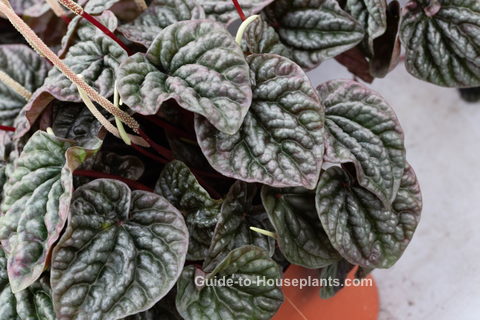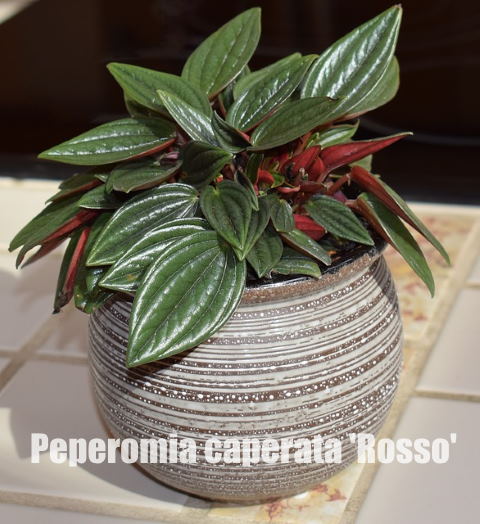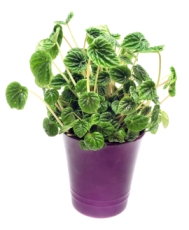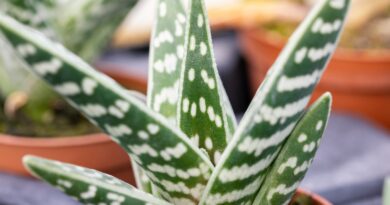Peperomia caperata Indoor Plant Care
Botanical Name: Peperomia caperata
A member of the Piperaceae family, this compact plant has short stems covered by heart-shaped, deeply ridged leaves. The leaves are green, sometimes with a blush of red, and dark green veins. If your P. caperata doesn’t look like this one, there’s good reason. Newer cultivars give this popular houseplant a whole new look. Some of the varieties are listed below.
In summer through early fall, you may see slender flower spikes. They rise tall above the mound of foliage, growing from the base of the plant with reddish-purple stems. Whether you like the “flowers” or not…they are one of the hallmarks of Peperomia caperata.
 Peperomia caperata has unusual flowers — an abundance of tall, slender spikes.
Peperomia caperata has unusual flowers — an abundance of tall, slender spikes.Peperomia Caperata Varieties
The most common cultivar is ‘Emerald Ripple’ with a compact growing habit… ‘Variegata’ has white leaves with a splash of green. Some have reddish-green leaves, such as ‘Burgundy’. Another favorite is ‘Rosso’ with smooth, shiny, quilted foliage. Choose a plant with the leaf colors and patterns that you like. They’re all easy to grow.
 Peperomia Caperata ‘Rosso’ is stunning with shiny, green and burgundy leaves.
Peperomia Caperata ‘Rosso’ is stunning with shiny, green and burgundy leaves.Peperomia Caperata Problems, Solutions and Answers
Peperomia caperata is usually trouble-free. The only thing that really bothers this plant is soggy soil.
Don’t overwater. Allow the soil to dry out slightly between waterings. Water sparingly in winter, when growth is slower. Wilting leaves is likely because drainage is poor and its roots are not getting enough oxygen.
Black stems and lower leaves are a symptom of soggy soil. If only a few stems turn black, they can be cut off at the base. Ease the plant out of its pot and take a peek at its roots. Are they black and mushy? If so, the plant likely won’t recover…toss it out.
Repot in spring, only when the plant has outgrown its pot. Move it into a pot that’s only slightly larger, because a container that’s too big will hold too much water and may cause root rot. Also, be sure to use a container with a drainage hole. If you want to cover up a plain nursery pot, slip it into a cachepot (a decorative planter without drainage holes). I put small river stones in the bottom of my cachepots to keep the pot above the drainage water.
Leaf drop may be caused by a build-up of salts in the soil from soft water or too much fertilizer. You can see accumulated salts as a white crusty deposits on the surface of the soil. Fortunately, it’s easy to flush out excess salts.
How to flush out salts: Pour plenty of room-temperature water over the soil, drenching the soil and allowing the excess water to drain out of the drainage holes for several minutes. Then pour more water. Empty the drainage tray.
Are Peperomias poisonous? No — they are safe to grow in a home with pets. They are non-toxic to cats, dogs and people.
Its textured leaves and low-growing mound of foliage make it an ideal addition to a dish garden or a terrarium. And it loves the humidity.
Peperomia Caperata Care Tips

Origin: Brazil
Height: 8 in (20 cm)
Light: Low to bright light. Protect this plant from direct sunlight. Light from an east- or north-facing window works best. Peperomia caperata thrives under indoor grow lights, making it a good choice for an office plant.
Water: Keep soil barely moist. Allow the top inch of soil to dry between waterings. Water less in winter, allowing the top half of the soil to dry out before watering again.
Humidity: Moderate — around 40-50% relative humidity. Use a humidity tray or room humidifier, if needed. Or put your plant in an open terrarium — it thrives in the moist air like its native rain forest habitat.
Temperature: Average room temperatures (65-75°F/18-24°C) year-round.
Soil: Light peat moss potting mix that contains perlite or sand to help drainage. Peperomia likes some air around its roots. This plant will easily get stem and/or root rot if the potting medium is kept wet.
Fertilizer: Feed monthly spring through fall with a liquid or water-soluble fertilizer, diluted by half. Stop feeding in winter, when growth is slow.
Propagation: Take leaf or stem tip cuttings in spring.




